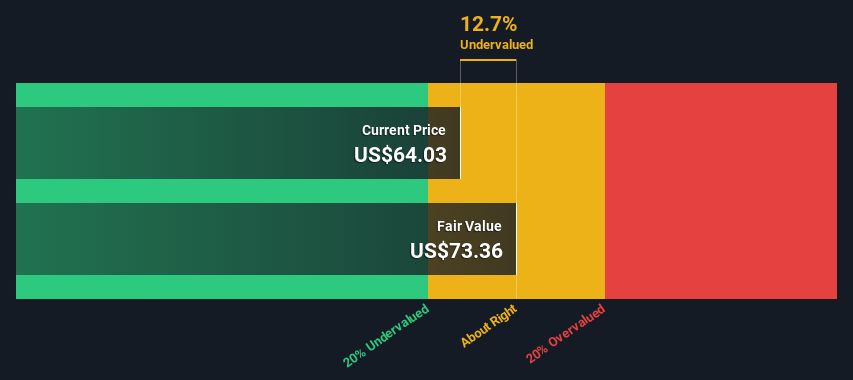Estimating The Fair Value Of Federal Signal Corporation (NYSE:FSS)
July 3, 2023
Key Insights
The projected fair value for Federal Signal is US$73.36 based on 2 Stage Free Cash Flow to Equity
Federal Signal’s US$64.03 share price indicates it is trading at similar levels as its fair value estimate
Analyst price target for FSS is US$61.60 which is 16% below our fair value estimate
Does the July share price for Federal Signal Corporation (NYSE:FSS) reflect what it’s really worth? Today, we will estimate the stock’s intrinsic value by taking the expected future cash flows and discounting them to today’s value. The Discounted Cash Flow (DCF) model is the tool we will apply to do this. Believe it or not, it’s not too difficult to follow, as you’ll see from our example!
Companies can be valued in a lot of ways, so we would point out that a DCF is not perfect for every situation. If you want to learn more about discounted cash flow, the rationale behind this calculation can be read in detail in the Simply Wall St analysis model.
Check out our latest analysis for Federal Signal
The Method
We use what is known as a 2-stage model, which simply means we have two different periods of growth rates for the company’s cash flows. Generally the first stage is higher growth, and the second stage is a lower growth phase. To begin with, we have to get estimates of the next ten years of cash flows. Where possible we use analyst estimates, but when these aren’t available we extrapolate the previous free cash flow (FCF) from the last estimate or reported value. We assume companies with reduced free cash flow will slow their rate of depreciation, and that companies with growing free cash flow will see their growth rate slow, over this period. We do this to reflect that growth tends to slow more in the early years than it does in later years.
Generally we assume that a dollar today is more valuable than a dollar in the future, so we need to discount the sum of these future cash flows to arrive at a present value estimate:
10-year free cash flow (FCF) forecast
2024 | 2025 | 2026 | 2027 | 2028 | 2029 | 2030 | 2031 | 2032 | 2033 | |
Leveraged FCF ($, Millions) | US$197.6m | US$236.8m | US$257.2m | US$278.8m | US$295.0m | US$308.9m | US$321.1m | US$332.0m | US$341.9m | US$351.3m |
Growth Rate Estimate Source | Analyst x3 | Analyst x1 | Analyst x1 | Analyst x1 | Est @ 5.83% | Est @ 4.71% | Est @ 3.93% | Est @ 3.38% | Est @ 3.00% | Est @ 2.73% |
Present Value ($, Millions) Discounted @ 8.3% | US$182 | US$202 | US$202 | US$203 | US$198 | US$191 | US$184 | US$175 | US$167 | US$158 |
(“Est” = FCF growth rate estimated by Simply Wall St)
Present Value of 10-year Cash Flow (PVCF) = US$1.9b
We now need to calculate the Terminal Value, which accounts for all the future cash flows after this ten year period. For a number of reasons a very conservative growth rate is used that cannot exceed that of a country’s GDP growth. In this case we have used the 5-year average of the 10-year government bond yield (2.1%) to estimate future growth. In the same way as with the 10-year ‘growth’ period, we discount future cash flows to today’s value, using a cost of equity of 8.3%.
Terminal Value (TV)= FCF2033 × (1 + g) ÷ (r – g) = US$351m× (1 + 2.1%) ÷ (8.3%– 2.1%) = US$5.8b
Present Value of Terminal Value (PVTV)= TV / (1 + r)10= US$5.8b÷ ( 1 + 8.3%)10= US$2.6b
The total value, or equity value, is then the sum of the present value of the future cash flows, which in this case is US$4.5b. In the final step we divide the equity value by the number of outstanding shares. Compared to the current share price of US$64.0, the company appears about fair value at a 13% discount to where the stock price trades currently. Valuations are imprecise instruments though, rather like a telescope – move a few degrees and end up in a different galaxy. Do keep this in mind.

Important Assumptions
We would point out that the most important inputs to a discounted cash flow are the discount rate and of course the actual cash flows. If you don’t agree with these results, have a go at the calculations yourself and play with the assumptions. The DCF also does not consider the possible cyclicality of an industry, or a company’s future capital requirements, so it does not give a full picture of a company’s potential performance. Given that we are looking at Federal Signal as potential shareholders, the cost of equity is used as the discount rate, rather than the cost of capital (or weighted average cost of capital, WACC) which accounts for debt. In this calculation we’ve used 8.3%, which is based on a levered beta of 1.044. Beta is a measure of a stock’s volatility, compared to the market as a whole. We get our beta from the industry average beta of globally comparable companies, with an imposed limit between 0.8 and 2.0, which is a reasonable range for a stable business.
SWOT Analysis for Federal Signals
strength
Weaknesses
Opportunity
Threats
Moving On:
Although the valuation of a company is important, it is only one of many factors that you need to assess for a company. The DCF model is not a perfect stock valuation tool. Rather it should be seen as a guide to “what assumptions need to be true for this stock to be under/overvalued?” For example, changes in the company’s cost of equity or the risk free rate can significantly impact the valuation. For Federal Signal, we’ve put together three pertinent items you should look at:
risks: To that end, you should be aware of the 1 warning sign we’ve spotted with Federal Signal .
Future Earnings: How does FSS’s growth rate compare to its peers and the wider market? Dig deeper into the analyst consensus number for the upcoming years by interacting with our free analyst growth expectation chart.
Other Solid Businesses: Low debt, high returns on equity and good past performance are fundamental to a strong business. Why not explore our interactive list of stocks with solid business fundamentals to see if there are other companies you may not have considered!
PS. The Simply Wall St app conducts a discounted cash flow valuation for every stock on the NYSE every day. If you want to find the calculation for other stocks, just search here.
Have feedback on this article? Concerned about the content? get in touch with us directly. Alternatively, email editorial-team (at) simplywallst.com.
This article by Simply Wall St is general in nature. We provide commentary based on historical data and analyst forecasts only using an unbiased methodology and our articles are not intended to be financial advice. It does not constitute a recommendation to buy or sell any stock, and does not take account of your objectives or your financial situation. We aim to bring you long-term focused analysis driven by fundamental data. Note that our analysis may not factor in the latest price-sensitive company announcements or qualitative material. Simply Wall St has no position in any stocks mentioned.
Join A Paid User Research Session
You’ll receive a US$30 Amazon Gift Card for 1 hour of your time while helping us build better investing tools for the individual investors like yourself. Sign up here
